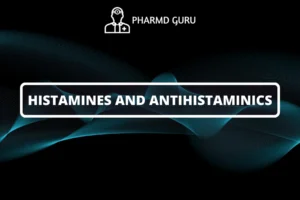ADRENERGIC AND ANTI-ADRENERGIC DRUGS
Adrenergic and anti-adrenergic drugs are medications that modulate the activity of the adrenergic system, which is part of the autonomic nervous system (ANS). These drugs target adrenergic receptors, which are activated by neurotransmitters like norepinephrine and epinephrine. In this article, we will provide an overview of adrenergic and anti-adrenergic drugs, their classifications, mechanisms of action, and therapeutic uses.
SCROLL DOWN TO THE BOTTOM OF THIS PAGE FOR ACTUAL NOTES.
TABLE OF CONTENTS:
- Introduction
- Adrenergic Receptors
- Adrenergic Agonists
- Direct-Acting Agonists
- Indirect-Acting Agonists
- Anti-Adrenergic Drugs
- Alpha-Adrenergic Antagonists
- Beta-Adrenergic Antagonists
- Therapeutic Applications
Introduction
The adrenergic system plays a crucial role in regulating various physiological functions, including heart rate, blood pressure, and smooth muscle contraction. Adrenergic drugs either mimic or block the effects of adrenergic neurotransmitters, allowing for the modulation of these functions.
Adrenergic Receptors
Adrenergic receptors are classified into two main types: alpha-adrenergic receptors and beta-adrenergic receptors. These receptors are further divided into subtypes, such as alpha-1, alpha-2, beta-1, and beta-2 receptors. Each subtype has distinct functions and locations within the body.
Adrenergic Agonists
Adrenergic agonists, also known as sympathomimetics, are drugs that activate adrenergic receptors. They can be classified into two types: direct-acting agonists and indirect-acting agonists.
Direct-Acting Agonists
Direct-acting agonists bind directly to adrenergic receptors and activate them, producing physiological responses. Examples of direct-acting agonists include epinephrine, norepinephrine, and dopamine. These drugs are used in the treatment of conditions such as hypotension, asthma, and cardiac arrest.
Indirect-Acting Agonists
Indirect-acting agonists enhance the release or inhibit the reuptake of norepinephrine from nerve terminals, leading to increased adrenergic activity. Examples of indirect-acting agonists include amphetamines and cocaine. These drugs can be used in the treatment of attention deficit hyperactivity disorder (ADHD) and narcolepsy.
Anti-Adrenergic Drugs
Anti-adrenergic drugs, also known as adrenergic antagonists, block the effects of adrenergic neurotransmitters. They can be further classified into two types: alpha-adrenergic antagonists and beta-adrenergic antagonists.
Alpha-Adrenergic Antagonists
Alpha-adrenergic antagonists block the alpha-adrenergic receptors, leading to vasodilation and relaxation of smooth muscles. These drugs are used in the treatment of conditions such as hypertension, benign prostatic hyperplasia (BPH), and Raynaud’s disease. Examples of alpha-adrenergic antagonists include prazosin, doxazosin, and tamsulosin.
Beta-Adrenergic Antagonists
Beta-adrenergic antagonists, also known as beta-blockers, block the beta-adrenergic receptors. They are further classified into selective (beta-1) and non-selective (beta-1 and beta-2) antagonists. Beta-blockers are commonly used in the management of hypertension, angina, arrhythmias, and heart failure. Examples of beta-adrenergic antagonists include propranolol, metoprolol, and atenolol.
Therapeutic Applications
Adrenergic and anti-adrenergic drugs have a wide range of therapeutic applications. Some examples include:
- Adrenergic agonists used in the treatment of anaphylaxis, shock, and bronchial asthma.
- Alpha-adrenergic antagonists used to manage hypertension and BPH.
- Beta-adrenergic antagonists used in the treatment of hypertension, angina, and arrhythmias.
ACTUAL NOTES:




